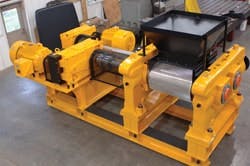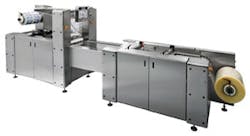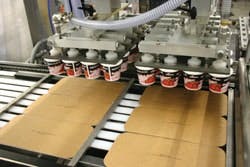Over the last few years, green has become an all-encompassing and often meaningless marketing buzzword. But in the real engineering-based world of machine builders, robot builders and their customers, greening the environment is inseparable from saving some green.
“Just focusing on being green doesn’t improve our market position,” observes Volker Klocke, Ing, senior controls project engineer with GL&V Paper Group in Lenox, Mass. GLV makes paper manufacturing machinery, winders and slitting systems in particular. “It’s instead the combination of functionality, safety and energy efficiency that makes our machines better in ways that matter to our customers,” adds Klocke.
Diane Trentini, director of marketing and sales operations for system integrator Optimation Technology in Rush, N.Y., agrees. “Good machine design means meeting design requirements while being cost-effective, energy-efficient and environmentally sustainable. All these criteria must align to justify a green machine.”
Green’s a FadMachine Builder Nation doesn’t operate in a vacuum from public opinion, as many products produced with machines eventually find their way to consumer use. So when environmental opinions change, machine builders are affected.Just such a big change has taken place recently in the U.S., with public concern about the environment taking a precipitous drop. Data from a recent U.S. survey conducted by the Pew Research Center for the People & the Press unsurprisingly shows that the two top priorities are the economy and jobs (www.ControlDesign.com/concerns).Concern for the environment and the related subject of global warming were ranked 16th and 20th respectively out of 20 issues. Pew’s analysis notes that public concern for environmental issues is very volatile, rising and falling based on matters such as the economy and foreign policy.The message for machine builders is clear. Sustainable competitive advantage is based on delivering real cost and performance benefits. Coloring these benefits green can only help, but trying to sell green as an extra cost item just won’t work. The public won’t buy it, and machine builders cannot buck public opinion and succeed. |
Another machine builder cautions against green hype. “We don’t see anything applicable to our machines as green, and using such a term would be nothing more than a marketing ploy with little if any real meaning,” says Leon Drake, chief engineer at Dynatorch, a manufacturer of CNC plasma cutting machines in Paducah, Ky.
Most everyone we spoke with agreed that green won’t sell machines unless it’s accompanied by real cost or performance improvements. But it turns out that many cost/performance advancements are green-related and have been spurred by the environmental movement.
Cost and performance improvements tinged with green are in big demand and don’t go in and out of fashion. Perhaps the leading way to go green, improve machine performance and cut machine operating costs is to cut energy use.
Green Starts With Energy Savings
Even when it costs more to make an energy-efficient machine, operating savings can offset the expense. Touting a machine’s energy efficiency as a green benefit can provide a competitive advantage.
“Green for us mainly means making more energy-efficient machines to reduce energy consumption by our customers,” explains Klocke of GLV. “Toward that end, we always try to have the low-energy state be the safe and default state for our machines. Another way to save energy is to reduce the time to switch a machine completely off and then on again.”
Partner Pak in Huntington Beach, Calif., manufactures machines to seal clamshell packages using UV adhesive technology. It also designs custom packing machinery with SCARA robots to pick and place products or dispense adhesive. By using a different sealing technology than its competitors, Partner Pack says it achieves a quantum leap in energy savings. “Our UV sealing method allows a packaging line to be fully automated and only uses about 10% of the energy of more traditional sealing methods such as RF or sonic,” claims Helcio Trindade, vice president of engineering at Partner Pak. “We have been able to capitalize on our energy savings as part of sustainability initiatives endorsed by Wal-Mart, Costco and other major retailers. These firms and some of our other larger customers are buying machines from us because our entire packaging process is green.”
Building a green machine doesn’t cost more, says Trindade, and “it gives our sales force one more tool to sell against the competition. If a machine is designed to use less energy, the electric components from motors to wiring to cabinets can be sized smaller and less expensive.”
Cut Waste
Cutting waste is a great way to go green while saving big bucks for OEM customers. “The biggest environmental payoff in packaging comes not from eco-design of the machine, but from reduction in packaging materials,” says Jarrett Campbell, segment marketing manager for packaging machinery at Schneider Electric.
Green Machines1. Save energy
|
“Some shrink wrapper manufacturers guarantee up to a 25% reduction in film usage through gentler handling of thin-gauge films and through more precise cutting/sealing that produces less edge scrap,” notes Campbell. “The use of these films and reductions in waste are only possible through the use of leading-edge, servo-based motion-control technology.”
Another example of automation technology that enables material savings is Cyclero, a soft can product that uses advanced machinery to form and ultrasonic weld a can-shaped flexible package. “The use of this design reduces material consumption by up to 80% compared to flexible bag packaging,” adds Campbell.
Recycle
Recycling can drive machine builder businesses in a number of ways. The first is directly, as with Break Rubber Technologies in North Liberty, Ind., an OEM that manufactures and rebuilds mills that grind recycled tires into crumb rubber (Figure 1).
REGENERATED POWER
Figure 1: This Break Rubber mill uses regenerative motor controls to provide high friction ratios while converting waste heat from the 125 hp slave motor into power shared with the 250 hp master motor via a common 900 Vdc bus. The end result is higher production with lower power consumption.
Source: Break Rubber Technologies
Crumb rubber is used in athletic fields, playgrounds and asphalt for roadways and is a cost-effective and environmentally friendly product that greatly reduces old tire inventory. Many NFL teams, colleges and even high schools are using synthetic turf that employs crumb rubber for support and cushioning.
Recycling is the driving force behind Break Rubber’s business, and the company embraces the green technology for energy saving when they build their machines. “Our mills use motor controls that increase production rates while cutting power consumption,” says Dave Futa, manager at Break Rubber. “The key for that is common bus regenerative drives. Our machines convert what normally would be waste heat into power shared with the other motors.”
The machine’s primary shaft roll is driven by a 250 hp motor, and the secondary roll is driven by a 125 hp motor. The secondary roll runs in a regenerative mode due to the forces of the shredding application. The two rolls use parallel-shaft, helical-gear units to produce a combined torque of nearly 800,000 lb-in. “These 28:1 gear units are more than 94% efficient,” explains Tom Ellis, district sales manager with SEW-Eurodrive. Ellis’ company supplies parallel-shaft helical-gear units to drive the motors on the Break Rubber machines. “They typically replace other less-efficient technologies like worm gear, which is about 70% efficient or open-spur gearing which is about 80-85% efficient.”
Break Rubber’s customers appreciate the energy savings of their machines. Recycling Technologies International in Hanover, Pa., was using a conventional single motor direct drive 250 hp cracker mill with a fixed friction ratio and roll speeds. It switched to Break Rubber’s mill and realized dramatic savings.
“The dual-drive mills generate up to 30% more material by employing twice the horse power while consuming a third less power,” notes Tim Leighty, former plant manager at Recycling Technologies and now an independent consultant to the scrap tire and rubber recycling industry.
Resuse of waste energy also is important to CP Packaging in Appleton, Wis. The company designs and manufactures vacuum packaging machinery, primarily for the food industry. Its machines are cyclic, so each process has an acceleration and deceleration component to make a given product.
RECYCLED ENERGY
Figure 2: This horizontal form/fill/seal machine from CP Packaging stores and reuses deceleration energy like a hybrid car. All machine motion axes are tied together via a common power bus so that one section's deceleration energy can be used to provide power for another section’s acceleration needs.
Source: CP Packaging
Its machines store and reuse deceleration energy in the same way a hybrid car does. A common power bus ties together all the motion axes on the machine. One section's deceleration energy powers another section’s acceleration requirement. The battery or storage device is in the power supply in the form of a capacitor. By storing and reusing energy, CP’s machines don't lose the energy as heat (Figure 2).
"We don't create the amount of heat a normal drive system would, so we don't have to cool the controls cabinets," notes Ray Buchko Jr., vice president of operations at CP Packaging.
"Because the drive and motors are one integral package, we reduce our purchase parts count by 50%, our cabinet space by 70% and our motor cabling by 80%. Ours is truly a green machine in terms of energy usage and purchased components," exclaims Buchko.
"Green means designing the machine for maximum efficiency from the ground up, instead of just taking an old design and adding a more efficient motor. Significant energy and component savings can only be achieved when questioning everything associated with the process," believes Buchko.
Repurpose
Recycling doesn’t affect every OEM business as directly as Break Rubber Technologies, but recycling is just one way to reuse materials. Another is to repurpose equipment and extend its useful life.
Pearson Packaging in Spokane, Wash., manufactures secondary packaging systems that include case erectors, case sealers, loaders, palletizers and bag inserters. Pearson finds that reusability provides benefits to its customers.
“Our packaging systems are designed so that our customers can redeploy machine robots to handle new products or package designs,” says Peter Lawton, director of engineered systems for robotics at Pearson. “Our core equipment, such as case erectors and sealers, can handle a wide variety of case sizes. So many times an entire secondary packaging system can be used for different products or packaging with just a new end-of-arm tool for a robot. In many cases this eliminates the need to scrap an entire line of equipment when customers change their products.”
Green Is Not Enough
“Green” has become an all-encompassing and often meaningless marketing buzzword. But in the real engineering-based world of machine builders, greening the environment is inseparable from saving some green. How green is your machine-building? Sound off at ControlDesign.com/greenmfg.
For some OEMs, green is the driving force behind customer demand for their products. The Watertronics sidebar shows how one company built its business around green. In this case, the OEM created a product that cleans water in a more environmentally friendly fashion. Watertectonics finds that combining green with performance improvements is a winning combination for its customers.
Replace Materials With Automation
A good way to go green is to replace materials with automation. Fieldbus technology uses less wire, less conduit, fewer terminal strips and smaller enclosures, for example.
Another way to use automation to reduce material use is by combining the functions of multiple components into one platform. “We find that centralized control and distributed I/O reduce components to a minimum,” claims Corey McAtee, product manager at Beckhoff Automation. “Combining PLC, motion control and HMI functionality on one hardware device cuts the number of control components. Distributed I/O leads to minimized wiring and cabinet space, and our slice I/O design allows purchasing only needed I/O points. To reduce use of mechanical parts and improve performance, we provide a camming library for our controllers. This library enables programmers to digitally cam or gear motors together, removing the need for fixed mechanical components.”
Beyond Green
It’s not enough just to claim your machine is green. You’d better back it up with specific performance and cost advantages. But at the same time, you can’t ignore green as many machine improvements are directly tied to environmental benefits.
Besides producing a machine that directly performs green function such as recycling materials or cleaning water, machine builders can go green many ways.
“Green machines minimize and optimize the amount of material used through part reduction, changes in the type or quantity of materials used and replacement of components with automation,” notes Darren Elliott, global technical resource manager for OEM Business Solutions at Rockwell Automation. “Switching to stainless steel can eliminate the need for painting and make machine materials easier to recycle. Designing machines that can be reconditioned easily for reuse helps your customers and the environment.”
Control System Powers Pollution Control ProcessWatertectonics in Everett, Wash., makes automated storm-water and process-water-treatment equipment. Its electrocoagulation (EC) process uses electrical current instead of chemicals to remove heavy metal particles and soluble pollutants from water. An EC system consists of pairs of conductive metal plates that apply an electric field to contaminated water. As a result, the primarily negatively charged contaminants combine with the positively charged metal plate, initiating the coagulation process. To optimize and automate the EC reaction, the control system must manage multiple variables including voltage, amperage, flow rate and cell chamber residence time. Watertectonics found that conventional control components such as PLCs couldn’t effectively control the EC reaction, so they found an alternative. “The system uses a National Instruments Compact FieldPoint programmable automation controller (PAC),” says Scott Lindblad, national account manager with Watertectonics. “The PAC easily integrates with different transducers as well as with an external measurement system for pH, conductivity and turbidity. We also used the controller’s wide range of data communication capabilities—such as Modbus, OPC and Web communication—for remote access and control,” explains Lindblad. “By using a PAC instead of a PLC or multiple customized systems, we’re able to provide real-time pH and turbidity control. The system also monitors components for predictive maintenance and recommends an exchange of consumables when needed. Clients use logged information for automating the required water quality and discharge reports,” concludes Lindblad. |
Six Keys to Sustainable Manufacturing“The federal government estimates that manufacturing uses about one-third of the energy consumed in the U.S., so manufacturing companies can play an important role in building a sustainable future by following these six steps,” says Scott Hibbard, vice president of technology at Bosch Rexroth.
|
VACUUM-PACKED
Figure 3: Packaging machine builder Delkor Systems uses a vacuum gripper system in its machines for faster and more reliable packaging. The system saves energy and also allows Delkor to use fewer vacuum effectors when handling different shapes and sizes of yogurt cups.
Source: Delkor Systems
Vacuum System Doesn’t Suck Energy
Delkor Systems in Circle Pines, Minn. makes end-of-line packaging systems that automatically form, load, inspect, wrap and seal secondary packaging trays, cartons and cases (Figure 3). Delkor uses an innovative vacuum system from PIAB to cut energy use.
“By preventing loss of vacuum pressure through better system design, fewer effectors are needed when handling different shapes and sizes of yogurt cups—resulting in faster and easier changeover with reduced downtime,” says Matt Maté, engineering manager at Delkor.
“We often employ a decentralized vacuum system that reduces energy costs for our customers by generating vacuum closer to the points of use,” adds Maté. Putting the source of vacuum directly at points-of-use cuts vacuum pressure losses as compared to a centralized system by shortening the distance from vacuum generation to use.
Another energy saving control technique used by Delkor is automatically switching off the vacuum pump once it achieves a set suction level. When vacuum is needed, the control system switches the pump back on.










